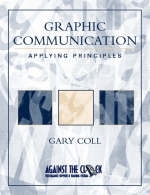
Graphic Communication
Pearson (Verlag)
978-0-13-030516-9 (ISBN)
- Titel ist leider vergriffen;
keine Neuauflage - Artikel merken
For courses in Graphic Communication and Graphic Design in departments of Journalism and Mass Communication.
This text/exercise manual is designed for students in a variety of programs, including journalism, mass communication, marketing, advertising, and public relations—careers in which professionals are required to produce high quality printed materials. It prepares them for the broad range of publication challenges they will face on the job, providing extensive practice in converting well-written and edited copy into readable and attractive printed materials, including brochures, letterheads and business cards, signage, packaging materials, or even posters. The exercises engage students in the types of thinking needed to engage others graphically and to produce reasonably professional materials, and focus on the full range of both traditional and computerized tools used to get the job done in a variety of settings.
1. Autobiography Assignment.
2. Trim and Type Pages, Margins, Constants, and Master Pages.
3. Measurement in the Graphic Arts.
4. Type and Establishing a Type Policy for Your Autobiography.
5. Finding and Using the Optical Center, Progressive Margins, Marking Up Type.
6. Autobiography Title Page.
7. Processing Photographs.
8. Author's Blurb and Photograph and Chapter Opening Pages.
9. Preparing Thumbnails of Book Jacket and Spine of Autobiography.
10. Book Jacket Cover and Spine.
11. Final Assembly of the Autobiography.
12. Proofreading.
13. Grids and Gridding.
14. Résumé.
15. Stationery Package: Identity Marks, Letterheads, Envelopes and Business Cards.
16. Copyfitting.
17. Self-Guided Tour Brochure and Signage.
18. Numerals.
19. Retail Bag.
20. Posters.
21. Address Labels.
22. Checks and Checkbook Cover.
23. Money, Money, Money.
24. Juror Badge.
Glossary.
Index of Tasks
For Assignment 1: Developing working titles, subtitles.
For Assignment 2: Learning parts of a page, margins, trim and type pages. Learning to develop ideas using thumbnail sketches, and checking page roughs against initial thumbnails using the Thumbnail View in area composition programs such as QuarkXPress. Learning to make roughs using paste-up techniques or by assembling page elements in an area composition program. Creating master pages by hand or using an area composition program such as QuarkXPress or PageMaker.
For Assignment 3: Measuring type size using a line gauge or pica pole, or referring to typeface and size on the computer screen in a typesetting or area composition program such as QuarkXPress.
For Assignment 4: Developing a type policy for a publication or creating formatting specifications for text using electronic templates or the style feature of area composition programs such as QuarkXPress. Identifying type from different races.
For Assignment 5: Learning to locate and use the optical center of a page traditionally on a layout sheet or with the help of ruler guides in an area composition program such as QuarkXPress. Learning to place more than one element on a title page. Marking up type for typesetting and checking character and other attributes in dialog boxes in area composition programs such as QuarkXPress.
For Assignment 6: Learning to make registration trim marks in QuarkXPress and PageMaker.
For Assignment 7: Determining the space that visual copy will occupy in a layout; cropping and sizing of photographs using a scanning program such as Ofoto or a paint program such as Photoshop; resizing pictures within an area composition program such as QuarkXPress. Marking up photographs in the traditional manner or by providing for proper formatting in a paint program such as Photoshop or an area composition program such as QuarkXPress.
For Assignment 8: Developing a book blurb page (overleaf). Developing a book chapter title page.
For Assignment 11: Assembling and trimming book pages.
For Assignment 12: Proofreading galley proofs in hardcopy and learning to receive and send proofs to and from remote locations using the PDF format.
For Assignment 13: Developing, visualiziing, and using grids for publications using the Baseline Grid feature in an area composition and type program such as QuarkXPress.
For Assignment 14: Developing and assembling a résumé and setting up an electronic file for distribution over the Internet.
For Assignment 15: Proposing and developing a personal identity mark using Internet resources. Developing a stationery package, including letterhead, envelope, and business card.
For Assignment 16: Counting headlines to assure they fit space allocated to them and checking on fit and appearance in an area composition program such as QuarkXPress or PageMaker. Copyfitting text copy and checking by flowing text onto a page using an area composition program such as QuarkXPress or PageMaker.
For Assignment 17: Creating a brochure, combining type and visual copy using area composition program capabilities to combine text and visual copy in a variety of manners, including surprints, reverse surprints, and wraps. Developing signage.
For Assignment 18: Working with numerals by creating a watch face and a clock face.
For Assignment 19: Developing a promotional item for a retailer—a bag—using Internet resources.
For Assignment 20: Preparing a poster.
For Assignment 21: Developing a personal address label, with art, using the step and repeat feature of an area composition program such as QuarkXPress.
For Assignment 22: Developing a personally meaningful check and checkbook cover.
For Assignment 23: Developing a front and obverse of a paper currency bill.
For Assignment 24: Developing a juror badge for identification in a county court building.
| Erscheint lt. Verlag | 25.10.2001 |
|---|---|
| Sprache | englisch |
| Gewicht | 1000 g |
| Themenwelt | Mathematik / Informatik ► Informatik ► Grafik / Design |
| ISBN-10 | 0-13-030516-2 / 0130305162 |
| ISBN-13 | 978-0-13-030516-9 / 9780130305169 |
| Zustand | Neuware |
| Informationen gemäß Produktsicherheitsverordnung (GPSR) | |
| Haben Sie eine Frage zum Produkt? |
aus dem Bereich


